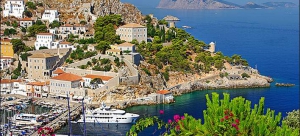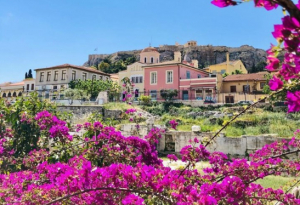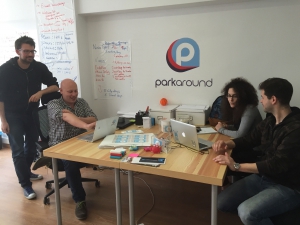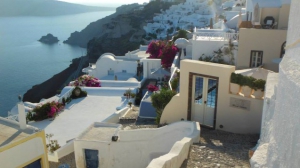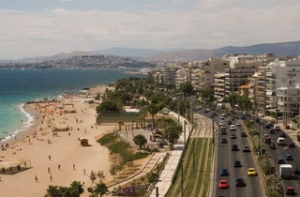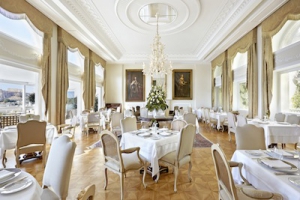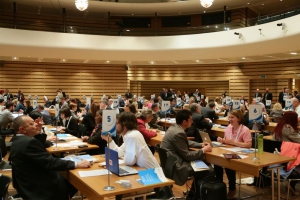COMMUNITY CORNER
XpatAthens
Thursday, 30 April 2015 22:46
Three Greek Islands Are The Most Popular In The Mediterranean
The top three spots on the list of the 30 most popular islands in the Mediterranean are occupied by the Greek islands of Ios, Hydra and Folegandros. The list was published after a survey on the search history and hotel price comparison of travel website Trivago.
The research was conducted based on searches made between April 1 and September 30, 2014, for trips made during that period. In order to conduct the survey, Trivago used information from the travelers’ reviews in 51 different platforms. The final results included islands with at least 50 hotels and 50 reviews per hotel.
In total, thirteen Greek islands were included on the list of the thirty most popular islands in the Mediterranean. As mentioned above, Ios, Hydra and Folegandros occupied the top three places, while the Greek island of Santorini ranked in 5th place, Mykonos in 6th, Naxos in 7th and Paros in 8th place. Furthermore, Spetses, Crete, Zakynthos, Kos, Rhodes and Corfu also made it on the list, in 14th, 16th, 20th, 23rd, 27th and 29th place respectively.
Source: Greek Reporter
by Ioanna Zikakou
Published in
Greece In The News
Tagged under
Monday, 29 April 2024 19:00
Greek May Day Customs And Traditions
May Day, celebrated on the first day of May, holds its roots deep in ancient Greek culture, marking the arrival of spring and paying homage to the Roman goddess Maia, associated with motherhood and fertility. In Greek mythology, Maia was a nymph, the mother of Hermes and a significant figure embodying the roles of midwife, nurse, and mother. Moreover, ancient Greeks dedicated the fifth month of the year to Demeter, the goddess of agriculture, and her daughter Persephone, symbolizing the return of spring as Persephone reunited with her mother after spending the winter in the underworld with Hades.
The ancient celebration of May Day continued throughout the centuries with solemnity through various customs and traditions. One of the oldest celebrations was the Anthesteria, the first ancient Greek flower festival.
Anthesteria included various processions were ancient Greeks would carry flowers to the sanctuaries and temples. The flower festival was first established in Athens and later in other ancient Greek cities. When the Romans arrived and conquered Greece, the May Day celebration continued to exist in some form but it was slightly changed, since both Romans and ancient Greeks believed that flowers represent the beauty of the gods and bring power, glory, happiness and health.
While the original meaning of May Day has evolved over the centuries, ancient Greek customs endure as cherished folk traditions. Today, May Day stands as a secular holiday celebrated across Europe, including Greece. One of the enduring customs in modern Greece involves crafting May Day wreaths from freshly picked flowers, adorning doorways until they naturally wither. This act of wreath-making serves as a reminder to reconnect with nature amidst the hustle and bustle of urban life.
In the Aegean islands, young girls used to get up at dawn and walk to the wells, carrying the flowers they had picked the previous day. They would fill vases with the “water of silence” and return to their homes without uttering a word. Later, they washed using the same water.
In villages of Corfu, another unique custom takes place on May Day. Residents parade through the streets carrying a cypress trunk adorned with yellow daisies and circled by a wreath of green branches. This trunk, known as the "May Log," is carried by young workers dressed in pristine white trousers and shirts, with red scarves around their necks, as they sing songs of May.
In Epirus, on the eve of May Day, children venture into the gardens, banging on cooking utensils and reciting magical incantations to ward off snakes.
Another highly theatrical custom is the "Resurrection of the May Child," found in various regions. A teenager portrays the deceased Dionysus in the fields while the village girls sing a lamenting song aimed at resurrecting him and, along with him, reviving the entire nature.
Greek May Day customs and traditions offer a glimpse into the rich tapestry of ancient beliefs and practices, weaving together elements of mythology, nature worship, and community celebration. As the world evolves, these timeless rituals continue to resonate, serving as a bridge between the past and the present, fostering a appreciation for the cyclical rhythms of life and the beauty of the natural world.
In Epirus, on the eve of May Day, children venture into the gardens, banging on cooking utensils and reciting magical incantations to ward off snakes.
Another highly theatrical custom is the "Resurrection of the May Child," found in various regions. A teenager portrays the deceased Dionysus in the fields while the village girls sing a lamenting song aimed at resurrecting him and, along with him, reviving the entire nature.
Greek May Day customs and traditions offer a glimpse into the rich tapestry of ancient beliefs and practices, weaving together elements of mythology, nature worship, and community celebration. As the world evolves, these timeless rituals continue to resonate, serving as a bridge between the past and the present, fostering a appreciation for the cyclical rhythms of life and the beauty of the natural world.
Published in
Greek Traditions
Tagged under
Monday, 29 April 2024 07:00
Protomagia - May Day In Greece
May 1st is International Labor Day and in Greece, it is called ‘Protomagia’ (literally meaning the first day of May). It is an urban holiday and people traditionally go to the countryside for picnics, fly kites, and gather wildflowers.
May 1st is a national holiday and this means that everything is closed, with the exception of cafes and food venues. Expect to have travel delays, demonstrations (typically peaceful), and heavy traffic!
Greek Protomagia & Folklore
The custom of Protomagia has its roots in Ancient Greece - it is a celebration of spring, nature, and flowers. Flower wreaths, typically made from hand-picked wildflowers, are hung on the doors of many homes in a way of welcoming nature and all things good.
May is the last month of spring and has taken its name from the Goddess Maia - a goddess who took her name from the ancient word Maia meaning great one or mother. May, according to Greek folklore, has two meanings: good and bad, rebirth and death. The custom celebrates the final victory of the summer over winter or as the victory of life over death, which dates back to ancient times, and culminates on the first day of May. This day was also dedicated to the goddess of agriculture Dimitra (or Demeter) and her daughter Persephone who on this day emerges from the underworld and returns to Earth. Her coming to Earth from Hades marks the blooming of nature and the birth of summer.
Some May Day History
May 1st is International Workers' Day, also known as Labor Day in some places. It is a celebration of laborers and the working classes that is typically promoted by the international labor movement, anarchists, socialists, and communists and occurs every year on the 1st of May. The date was chosen as International Workers' Day by the Second International to commemorate the Haymarket Affair, which occurred in Chicago on May 4, 1886.
May Day is a national public holiday in most European countries, however, not all countries celebrate the day specifically as Labor Day. Historically, the earliest May Day celebrations are traced back to the Floralia festival, a festival dedicated to Flora, the Roman goddess of flowers, that was held on April 27 during the Roman Republic era.
Published in
Greek Traditions
Tagged under
Thursday, 30 April 2015 12:49
Spring Sales In Athens: May 2 - 9
Spring sales start Saturday May 2 2015 and run until Saturday May 9 2015. The Commercial Association of Athens has suggests that shops remain open on Sunday, May 3 from 11 am to 6 pm, and in Piraeus from 11 am to 4 pm.
Happy shopping!!
Happy shopping!!
Published in
Local News
Tagged under
Thursday, 07 May 2015 20:26
ParkAround: The Innovative Solution To The Problem Of Parking In Athens
It’s a nightmare… for drivers in many areas. Finding parking in Athens is a difficult feat. However, things can become are lot easier with ParkAround. An innovative Greek Startup that gives you real time information about the availability and prices of car parks in the area you’re interested in. In fact, if you book a spot through ParkAround, you get major discounts. One of it’s Co-Founders, John Katsiotis, speaks to HuffPost Greece.
Finding parking is one of the biggest problems for drivers in Athens. How does your innovative app solve this issue?
Through ParkAround, drivers are able to book a parking spot in the nearest and cheapest car park in the area they want and to have total control of the price because they know beforehand the exact amount, which in many cases is reduced up to 80% through our exclusive discounts. In fact, 30% percent of traffic in the city is caused by drivers looking for parking. With ParkAround, drivers know in advance where they are going to park which means that they save valuable time for themselves but also for the other drivers moving around in the city.
How does ParkAround work?
ParkAround is available for web users as well as for iPhone and Android Smartphones. The driver fills in the address or the place (eg. restaurant, cinema etc) he would like to park and the app displays all the available car parks with information such as cost, distance, opening hours etc. Finally, the driver is able make a booking through the app and therefore guarantees exclusive discounts as well as a parking spot. ParkAround then informs the car park immediately so that when the driver arrives at the car park there’s a spot waiting for him!
Based on the information you have, do you think that the price of parking in the capital is high or low? And with that I mean, the initial pricing, independent of the discounts that you offer. I ask this because a lot of drivers think that the cost is quite high, especially for daily use.
The cost of parking is directly correlated with the area. What this means is that, in areas such as Syntagma and Kolonaki parking costs around15 euros for 3 hours and in areas such as Omonoia you can park with 10 euros for the whole day. Of course through ParkAround, drivers can park with one 1 euro per hour in Omonoia, 2 euros for 3 hours at Chalandri and 5 euros at Syntagma.
You recently got major funding of 185.000 euros. How easy is it for a Greek startup to receive funding?
As time goes by, the ecosystem of startups gets bigger which makes funding more attainable.
If I’m not mistaken, ParkAround has expanded to London. What differences have you noticed between Athens and London in terms of developing your startup?
One difference is that drivers in London book parking hours or even days before, while in Athens most of the bookings happen just a few minutes prior. In addition, the phenomenon of illegal parking is not present in London.
As you’ve stated in previous interviews, you intend on expanding to other European cities. What are your immediate plans in terms of your global expansion?
For the time being, we are focusing on the Athens market seeing that we recently launched a new service for parking at the airport and at Piraeus port and there are still more opportunities for expansion in the Attiki area and the rest of Greece. More specifically, in just a few months the new service for parking at the airport has been met favourably by drivers - especially as the Christmas holidays approach - as it offers parking at much cheaper rates than taxis and sometimes even public transport.
What problems or obstacles have you faced in your business venture so far?
The biggest challenge that we have faced is trying to educate the parking market on new technologies. ParκAround is a purely technological solution as it gives car parks a platform for smartly billing their customers. Nothing similar has happened before and therefore it has taken us a bit more time to educate the car parks on the advantages of using our service.
Let’s talk numbers, how many drivers in Athens use your app?
In Athens, we have 20.000 drivers that have downloaded ParkAround and we serve hundreds of drivers everyday through 90+ affiliated car parks.
To learn more about ParkAround, please visit their website HERE.
This is a translation of the article originally published on HuffingtonPost.gr
By: Yiannis Belegrinis
To learn more about ParkAround, please visit their website HERE.
This is a translation of the article originally published on HuffingtonPost.gr
By: Yiannis Belegrinis
Published in
People
Tagged under
Wednesday, 29 April 2015 16:03
Advice On Traveling To Santorini With Kids
You've been dreaming about visiting Santorini, but have heard it's not ideal for children? Here is some great advice to help you experience the beauty of Santorini together as a family!
Avoid Caldera and that part of the island. Instead, consider Kamari or Perissa. It will take you less than 30 minutes to get from these places to Caldera or Oia, where you can enjoy the gorgeous view. Although Kamari and Perissa are a little less scenic, they have more hotels with bigger pools and easier access to the beach – and, most importantly, their prices tend to be lower. Your kids will be able to find other kids to play with more easily, too.
Be careful of the hotel you choose, as many of the hotels, especially in Caldera and Oia, are tailored to couples and newlyweds and simply do not take children because of noise problems and safety issues (cliffs and staircases).
Take day trips into the towns in the early morning (before it gets hot and the cruise ships arrive) or in the late afternoon when the cruise ships depart (around 3-4pm).
Find a hotel with a pool. Most beaches in Santorini have black volcanic sand which can be scorching hot under the midday sun.
Combine your stay with a trip to another island; there is a direct connection to Crete, Naxos and Mykonos.
There is a small water park in Perissa, Santorini Water Park, inside the Meltemi Hotel (free for guests). The water park has 3 pools, 3 water slides, and a kids’ play area. Other interesting activities would be the archeological site in Akrotiri and a visit to the Industrial Tomato Museum.
Tour the volcano by boat, but don’t expect craters or lava flows. Younger children might find the trip boring, and it will be pretty hot without much shade. The half-day tour might be a better choice for kids.
Check out Monolithos beach – it’s probably the most kid friendly beach in Santorini, with lots of sand and shallow water. Perissa and Kamari also have pretty beaches, but the water drops off very steeply in some sections.
To read more, please visit Kids Love Greece.
Published in
Kids Life
Tagged under
Tuesday, 09 May 2017 07:00
Summertime Club Crawl Along The Athens Riviera
As the weather begins to heat up, it's typical that local Greeks start frequenting their favourite beach bar restaurants along the Athenian riviera. Here's a look at some of the best beach bars and restaurants to kick off the season!
The famous spot by the beach for dining, drinking and dancing. Opens on April 30. Wooden tables by the sand for dinners, while others may prefer to drink a cocktail on the sunbeds under a moonlit starry night.
Address: Poseidonos Avenue, Kalamaki
Telelephone: 210 968 0800
Telelephone: 210 968 0800
The historic nightclub in the prime spot kicked off its operations on April 17. Live concerts and parties promise to lift summer vibes to the peak. What can be more relaxing than a brilliant view, sea breeze and some sushi?
Address: B’5 Vasileos Georgiou Street, Agios Kosmas Beach, Alimos
Telephone: 210 644 4308
Telephone: 210 644 4308
Aspro-Piato isn’t a club-restaurant per se but there’s music, the sea, and a reputation for the best food, with an emphasis on its meat menu. Typically, live Greek music is played. It moves from its Halandri winter location to Glyfada by the sea at the same venue where Cataralla was formerly located.
Address: Ελ.Βενιζέλου 42, Néa Smírni
Telephone: 210 933 3166
Telephone: 210 933 3166
Balux The House Project with its friendly homey feel allows guests to feel like they’re in the comfort of their own home… with the exception that home is by the sea. There’s a living room, play room, billiards, internet spot and – if you’re hungry – head to the restaurant with Italian cuisine and Mediterranean dishes. Sit on the lawn or, alternatively, on the comfy sunbeds while sifting sand through your fingers.
Address: 58 Poseidonos Avenue, Asteras, Glyfada
Telephone: 210 898 3577
Telephone: 210 898 3577
To read this article in full, please visit: Protothema
Published in
Pubs, Bars & Cafes
Tagged under
Wednesday, 29 April 2015 09:53
Good News For Greek Olive Oil
Warehouse wholesale company Costco has switched the sourcing of the extra virgin olive oil that goes into its Kirkland Signature 2-liter bottle from Italian sources, to providers from Greece.
This is good news for providers in Greece who have felt the punch of the financial crisis and even better news for the recognition Greek olive oil deserves.
The move across the Ionian Sea comes amid an apocalyptic season for Italy’s olive groves. A hot spring, a rainy summer and a pesky olive-eating fly conspired to create what Italian daily La Repubblica called “the black year of Italian olive oil.”
Production in Italy is expected to drop 34 percent this year, according to the International Olive Oil Council.
Prices have gone up accordingly: Italian extra-virgin olive oil in March was sold by producers for about $2.97 a pound, 84 percent more than a year earlier, according to the council.
For Costco, the reasoning appears to be purely financial— and not because Greek olive oil is far superior to its Italian counterpart. That drastic price hike must have been tough to swallow for the company that’s always looking for a good deal.
Costco Chief Financial Officer Richard Galanti said the availability of the extra-virgin olive oil Costco usually purchases from Italy is down to one-tenth of the normal level.
To read more, please visit: PappasPost
Published in
Local News
Tagged under
Tuesday, 28 April 2015 20:09
Tudor Hall Receives ‘Golden Chef’s Hat’ Award For Greek Cuisine
Tudor Hall Restaurant, located on the 7th floor of the King George hotel, has received two important gastronomic awards, a ‘Golden Chef’s Hat’ and the award of Greek Cuisine.
Tudor Hall with a grade 15.5/20 was awarded for the second year in a row with a ‘Golden Chef’s Hat’. According to ‘Athinorama’ magazine, which is the organizer of this institution, the dishes curated by Executive Chef of Hotel Grande Bretagne & King George Sotiris Evangelou and the Chef de Cuisine of the Tudor Hall restaurant Alexandros Koskinas, lend harmony in flavor, symmetry in appearance and an emotionally loden Greekness that is distinct and expressive. With other words, it’s a benchmark for modern creative cuisine.
The restaurant’s philosophy is to offer authentic Greek seasonal dishes with a modern twist, while a key element of differentiation is the use of fresh seasonal vegetables and raw materials.
Its commitment is to provide excellent hospitality and customer service by offering authentic exceptional experiences. This award is an important recognition of all this effort.
Published in
Restaurants In Athens
Tagged under
Tuesday, 28 April 2015 19:58
'Travel Trade Athens' Event Delivers 3000 Hosted Buyer Meetings
Some 3,000 individual business meetings between 88 hosted buyers from abroad and 190 Greek tourism professionals took place at the third Travel Trade Athens event held at the Megaron Athens International Conference Center.
Travel Trade Athens, jointly organized by the City of Athens Convention and Visitors Bureau (ACVB) and the European Tour Operators Association (ETOA), is the signature annual trade event for the Greek capital which hosts selected international buyers focused on Athens and Greece.
“So far the signs allow us to be more optimistic about the upcoming tourism season”, Athens Mayor Giorgos Kaminis said during the press conference that kicked off the event.
“The demand for Athens can be maintained as long as the basic conditions for the proper functioning of the city — stability and safety — are maintained for our guests.”
Mayor Kaminis said that the municipality plans to approach new markets and customer groups and build on last year’s impressive tourism
growth in the city through an “even more dynamic and targeted” participation in international tourism events.
Furthermore, he said the municipality will continue to hold fam trips to introduce Athens to foreign tourism professionals and mass media representatives, further improve the image and hospitality services of the Greek capital and upgrade the city’s online presence.
Travel Trade Athens 2015
This year’s trade event hosted a total of 88 buyers from 27 countries and active in markets such as MICE (Meetings, Incentives, Conferences and Exhibitions) and LGBT (Lesbian, Gay, Bisexual and Transgender).
This year’s trade event hosted a total of 88 buyers from 27 countries and active in markets such as MICE (Meetings, Incentives, Conferences and Exhibitions) and LGBT (Lesbian, Gay, Bisexual and Transgender).
The hosted buyers came from Egypt, Argentina, Australia, Bulgaria, Brazil, France, Germany, Denmark, Switzerland, the United States, India, Israel, Italy, China (Hong Kong), Cyprus, Lebanon, Malaysia, Great Britain, Norway, Netherlands, Portugal, Romania, Saudi Arabia, Serbia, Sweden, Turkey and Finland.
In terms of suppliers, 190 Greek tourism professionals were from Athens (70 percent) and other parts of Greece attended the event. According to the organizers, the 3,000 meetings held this year are expected to lead to numerous agreements and partnerships between foreign buyers and Greek tourism businesses. Over 3,500 individual business meetings were recorded between hosted buyers and Greek suppliers during the two previous Travel Trade Athens events.
To read more, please visit Greek Travel Pages.
Published in
Local News
Tagged under

